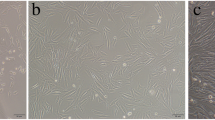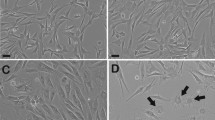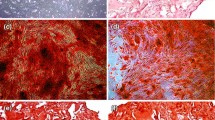Abstract
Periosteum-derived cells (PDCs) are being extensively studied as potential tissue engineering seed cells and have demonstrated tremendous promise to date. There is convincing evidence that culture medium could modulate the biological behavior of cultured cells. In this study, we investigate the effects of DMEM (low glucose) and RPMI 1640 on cell growth and cell differentiation of PDCs in vitro. PDCs isolated from Beagle dogs were maintained in DMEM and RPMI 1640, respectively. Then, the cell migration rate of periosteum tissues was analyzed. PDCs of the third passage were harvested for the study of proliferation and osteogenic activity. Proliferation was detected by MTT assay. Alkaline phosphatase activity and mineralized nodules were measured to investigate osteogenic differentiation. Our data demonstrated that DMEM induced alkaline phosphatase activity and strongly stimulated matrix mineralization in cell culture, while similar cell migration rates and proliferation behaviors were observed in the two culture conditions. Interestingly, the osteogenic differentiation of PDCs could be enhanced in DMEM compared with that in RPMI 1640. Thus, it can be ascertained that DMEM may serve as a suitable culture condition allowing osteogenic differentiation of dog PDCs.





Similar content being viewed by others
References
Agata H, Asahina I, Yamazaki Y, Uchida M, Shinohara Y, Honda MJ, Kagami H, Ueda M (2007) Effective bone engineering with periosteum-derived cells. J Dent Res 86(1):79–83. doi:10.1177/154405910708600113
Chen F, Hui JH, Chan WK, Lee EH (2003) Cultured mesenchymal stem cell transfers in the treatment of partial growth arrest. J Pediatr Orthop 23(4):425–429. doi:10.1097/00004694-200307000-00002
Choi YS, Noh SE, Lim SM, Lee CW, Kim CS, Im MW, Lee MH, Kim DI (2007) Multipotency and growth characteristic of periosteum-derived progenitor cells for chondrogenic, osteogenic, and adipogenic differentiation. Biotechnol Lett 30(4):593–601. doi:10.1007/s10529-007-9584-2
De Bari C, Dell’Accio F, Vanlauwe J, Eyckmans J, Khan IM, Archer CW, Jones EA, McGonagle D, Mitsiadis TA, Pitzalis C, Luyten FP (2006) Mesenchymal multipotency of adult human periosteal cells demonstrated by single-cell lineage analysis. Arthritis Rheum 54(4):1209–1221. doi:10.1002/art.21753
Declercq HA, Ridder LI, Cornelissen MJ (2005a) Isolation and osteogenic differentiation of rat periosteum-derived cells. Cytotechnology 49:39–50. doi:10.1007/s10616-005-5167-z
Declercq HA, Verbeeck RM, De Ridder LI, Schacht EH, Cornelissen MJ (2005b) Calcification as an indicator of osteoinductive capacity of biomaterials in osteoblastic cell cultures. Biomaterials 26(24):4964–4974. doi:10.1016/j.biomaterials.2005.01.025
Eklou-Kalonji E, Denis I, Lieberherr M, Pointillart A (1998) Effects of extracellular calcium on the proliferation and differentiation of porcine osteoblasts in vitro. Cell Tissue Res 292(1):163–171. doi:10.1007/s004410051046
Groeneveld MC, Everts V, Beertsen W (1994) Formation of afibrillar acellular cementum-like layers induced by alkaline phosphatase activity from periodontal ligament explants maintained in vitro. J Dent Res 73(10):1588–1592
Hasegawa N, Kawaguchi H, Hirachi A, Takeda K, Mizuno N, Nishimura M, Koike C, Tsuji K, Iba H, Kato Y, Kurihara H (2006) Behavior of transplanted bone marrow-derived mesenchymal stem cells in periodontal defects. J Periodontol 77(6):1003–1007. doi:10.1902/jop.2006.050341
Hildebrandt C, Büth H, Thielecke H (2009) Influence of cell culture media conditions on the osteogenic differentiation of cord blood-derived mesenchymal stem cells. Ann Anat 191(1):23–32. doi:10.1016/j.aanat.2008.09.009
Hou LT, Li TI, Liu CM, Liu BY, Liu CL, Mi HW (2007) Modulation of osteogenic potential by recombinant human bone morphogenic protein-2 in human periodontal ligament cells: effect of serum, culture medium, and osteoinductive medium. J Periodontal Res 42(3):244–252. doi:10.1111/j.1600-0765.2006.00940.x
Jansen EJ, Emans PJ, Guldemond NA, van Rhijn LW, Welting TJ, Bulstra SK, Kuijer R (2008) Human periosteum-derived cells from elderly patients as a source for cartilage tissue engineering? J Tissue Eng Regen 2(6):331–339. doi:10.1002/term.100
Kim WS, Kim HK (2005) Tissue engineered vascularized bone formation using in vivo implanted osteoblast-polyglycolic acid scaffold. J Korean Med Sci 20(3):479–482
Kim HS, Park JW, Yeo SI, Choi BJ, Suh JY (2006) Effects of high glucose on cellular activity of periodontal ligament cells in vitro. Diabetes Res Clin Pract 74(1):41–47. doi:10.1016/j.diabres.2006.03.034
Li YM, Schilling T, Benisch P, Zeck S, Meissner-Weigl J, Schneider D, Limbert C, Seufert J, Kassem M, Schütze N, Jakob F, Ebert R (2007) Effects of high glucose on mesenchymal stem cell proliferation and differentiation. Biochem Biophys Res Commun 363(1):209–215. doi:10.1016/j.bbrc.2007.08.161
Li H, Yan F, Lei L, Li Y, Xiao Y (2008) Application of autologous cryopreserved bone marrow mesenchymal stem cells for periodontal regeneration in dogs. Cells Tissues Organs. doi:10.1159/000166547
Lin NH, Grontho S, Bartold PM (2008) Stem cells and periodontal regeneration. Aust Dent J 53(2):108–121. doi:10.1111/j.1834-7819.2008.00019.x
Liu YK, Lu QZ, Pei R, Ji HJ, Zhou GS, Zhao XL, Tang RK, Zhang M (2009) The effect of extracellular calcium and inorganic phosphate on the growth and osteogenic differentiation of mesenchymal stem cells in vitro: implication for bone tissue engineering. Biomed Mater 4(2):25004. doi:10.1088/1748-6041/4/2/025004
Lopez-Cazuax S, Bluteau G, Magne D, Lieubeau B, Guicheux J, Alliot-Litht B (2006) Culture medium modulates the behaviour of human dental pulp-derived cells. Eur Cell Mater 11:35–42
Maeno S, Niki Y, Matsumoto H, Morioka H, Yatabe T, Funayama A, Toyama Y, Taguchi T, Tanaka J (2005) The effect of calcium ion concentration on osteoblast viability, proliferation and differentiation in monolayer and 3D culture. Biomaterials 26(23):4847–4855. doi:10.1016/j.biomaterials.2005.01.006
Matsumoto A (1995) The effect of cell environment on osteoblastic function. Nippon Yakurigaku Zasshi 105(5):273–283. doi:10.1254/fpj.105.273
Mizuno H, Hata K, Kojima K, Bonassar LJ, Vacanti CA, Ueda M (2006) A novel approach to regenerating periodontal tissue by grafting autologous cultured periosteum. Tissue Eng 12(5):1227–1335. doi:10.1089/ten.2006.12.1227
Perka C, Schultz O, Spitzer RS, Lindenhayn K, Burmester GR, Sittinger M (2000) Segmental bone repair by tissue-engineered periosteal cell transplants with bioresorbable fleece and fibrin scaffolds in rabbits. Biomaterials 21(11):1145–1153. doi:10.1016/S0142-9612(99)00280-X
Robert DG, Leslie AL (1997) A laboratory manual. Cold Spring Harbor Laboratory Press, Chicago
Steiner GG, Kallet MP, Steiner DM, Roulet DN (2007) The inverted periosteal graft. Compend Contin Educ Dent 28(3):154–161
Stolzing A, Coleman N, Scutt A (2006) Glucose-induced replicative senescence in mesenchymal stem cells. Rejuvenation Res 9(1):31–35. doi:10.1089/rej.2006.9.31
Youn I, Suh JK, Nauman EA, Jones DG (2005) Differential phenotypic characteristics of heterogeneous cell population in the rabbit periosteum. Acta Orthop 76(3):442–450
Youshimura Y, Hisada Y, Suzuki K, Deyama Y, Matsumoto A (1996) Effect of a low-calcium environment on alkaline phosphatase activity in embryonic rat calvarial bone cells in culture. Arch Oral Biol 41:41–45. doi:10.1016/0003-9969(95)00104-2
Zhang C, Hu YY, Cui FZ, Zhang SM, Ruan DK (2006) A study on a tissue-engineered bone using rhBMP-2 induced periosteal cells with a porous nano-hydroxyapatite/col-lagen/poly (l-lactic acid) scaffold. Biomed Mater 1(2):56–62. doi:10.1088/1748-6041/1/2/002
Zhang Y, Song J, Shi B, Wang Y, Chen X, Huang C, Yang X, Xu D, Cheng X, Chen X (2007) Combination of scaffold and adenovirus vectors expressing bone morphogenetic protein-7 for alveolar bone regeneration at dental implant defects. Biomaterials 28(31):4635–4642. doi:10.1016/j.biomaterials.2007.07.009
Zheng YX, Ringe J, Liang Z, Loch A, Chen L, Sittinger M (2006) Osteogenic potential of human periosteum-derived progenitor cells in PLGA scaffold using allogeneic serum. J Zhejiang Univ Sci B 7(10):817–824. doi:10.1631/jzus.2006.B0817
Zhu SJ, Choi BH, Huh JY, Jung JH, Kim BY, Lee SH (2006) A comparative qualitative histological analysis of tissue-engineered bone using bone marrow mesenchymal stem cells, alveolar bone cells, and periosteal cells. Oral Surg Oral Med Oral Pathol Oral Radiol Endod 101(2):164–169. doi:10.1016/j.tripleo.2005.04.006
Acknowledgments
This study was supported by the National Natural Science Foundation of China (30471892), the Natural Science Foundation of Fujian Province, China (2008J0085), and the Key Disciplines Research Foundation from School of Stomatology, Fujian Medical University (No. 2008-39). The authors thank Hong Chen and Lei Ma for technical assistance.
Author information
Authors and Affiliations
Corresponding author
Rights and permissions
About this article
Cite this article
Wu, X., Lin, M., Li, Y. et al. Effects of DMEM and RPMI 1640 on the biological behavior of dog periosteum-derived cells. Cytotechnology 59, 103–111 (2009). https://doi.org/10.1007/s10616-009-9200-5
Received:
Accepted:
Published:
Issue Date:
DOI: https://doi.org/10.1007/s10616-009-9200-5




